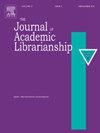应用GIS工具来呈现关于系列出版物的信息:一个建筑期刊的案例研究
IF 2.3
3区 管理学
Q2 INFORMATION SCIENCE & LIBRARY SCIENCE
引用次数: 0
摘要
本文的目的是指出,除了地理信息系统(GIS)在图书馆工作中已经普遍的应用之外,它的另一种潜在的使用形式。本文以某建筑期刊为例,强调将GIS工具集成到图书馆服务中,以改善数据可视化和用户体验。使用GIS技术将日志数据(如项目位置、作者和插图)与空间属性联系起来。该方法集成了像COBISS这样的数据库,并使用底图来定位参考文章和体系结构项目。该研究强调了地理信息系统的好处,例如更好地可视化地理空间数据,分析规划和实际的建筑物/城市地区维修的能力,以及改进书目信息的综合,以方便用户更好地访问。所使用的方法和基于地理信息系统技术的图示,以及现有资料与其他数据库之间的联系,都希望成为一种普遍模式,也适用于其他系列出版物。本文章由计算机程序翻译,如有差异,请以英文原文为准。
Application of GIS tools for presenting information about serial publications: The case study of an architectural journal
The purpose of this paper is to indicate, in addition to the already common applications of geographic information systems (GIS) in librarianship, another potential form of its use. The paper emphasizes the integration of GIS tools into library services to improve data visualization and user experience, using one particular architectural journal as an example. GIS technology is employed to link journal data, such as project locations, authorship, and illustrations, with spatial attributes. The approach integrates databases like COBISS and uses basemaps to georeference articles and architectural projects. The study highlights the benefits of GIS, such as better visualization of geospatial data, the capacity to analyse both planned and actual building/urban area maintenance, and improved integration of bibliographic information to facilitate better user access. The methods used and graphic presentations based on GIS technology, as well as the connection between existing information and other databases, aspire to be a universal model that is also applicable for other serial publications.
求助全文
通过发布文献求助,成功后即可免费获取论文全文。
去求助
来源期刊

Journal of Academic Librarianship
INFORMATION SCIENCE & LIBRARY SCIENCE-
CiteScore
5.30
自引率
15.40%
发文量
120
审稿时长
29 days
期刊介绍:
The Journal of Academic Librarianship, an international and refereed journal, publishes articles that focus on problems and issues germane to college and university libraries. JAL provides a forum for authors to present research findings and, where applicable, their practical applications and significance; analyze policies, practices, issues, and trends; speculate about the future of academic librarianship; present analytical bibliographic essays and philosophical treatises. JAL also brings to the attention of its readers information about hundreds of new and recently published books in library and information science, management, scholarly communication, and higher education. JAL, in addition, covers management and discipline-based software and information policy developments.
 求助内容:
求助内容: 应助结果提醒方式:
应助结果提醒方式:


